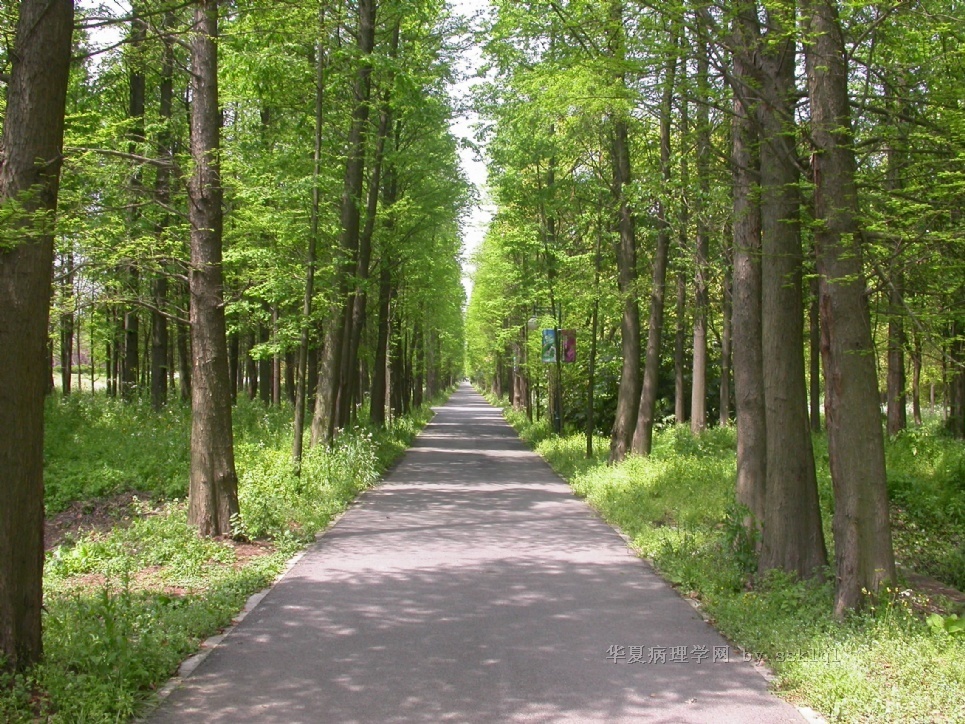| 图片: | |
|---|---|
| 名称: | |
| 描述: | |
- B6-2:北京军区总医院
B6-2:北京军区总医院
女,60岁。左乳肿物2月。2月前发现左乳肿物,有触痛,曾到多家医院就诊,诊为左乳腺增生病,未做治疗,肿物逐渐长大。查体:左乳外上象限扪及肿物,大小约3x3cm,边界不清,左腋窝查见直径约0.5cm淋巴结。手术中见肿物直径约3cm,质硬,边界不清。送冰冻检查,肉眼:灰白色肿物一块1.5x1.2x0.5cm,切面灰白色,实性,质韧。冰冻病理诊断为乳腺癌,行左乳改良根治术。术后化疗一疗程后前来会诊。

名称:图1
描述:图1

华夏病理/粉蓝医疗
为基层医院病理科提供全面解决方案,
努力让人人享有便捷准确可靠的病理诊断服务。
-
本帖最后由 于 2011-04-22 22:57:00 编辑
我也有一个鉴别诊断,Rosen's Breast Pathology, 3rd Edition上的资料如下:
Inflammatory Pseudotumor
There is no well-characterized lesion of the breast that qualifies for this diagnosis. The diagnosis has been mistakenly applied to metaplastic carcinoma, granulomatous mastitis, fibromatosis, and infarcts. Localized nodular lesions in the breast consisting of interlacing bundles of myofibroblastic cells with a prominent infiltrate composed mainly of plasma cells and lymphocytes have been diagnosed as inflammatory pseudotumors (Fig. 3.21) (103,104,105,106). Chetty and Govender (105) described three histologic patterns: nodular fasciitis, interlacing fascicles of spindle cells in variably collagenized stroma, and a hypocellular variant composed mainly of hyalinized collagen resembling a scar. The three cases described in their report had varied appearances with differing proportions of these elements. Elevated serum immunoglobulin G4 (IgG4) level, which is associated with sclerosing pancreatitis has been reported in a patient with inflammatory pseudotumor of the breast (107). Immunohistochemistry revealed many IgG4-positive plasma cells in the lesional tissue. The patient did not have clinical evidence of pancreatitis.
Four reported patients had a unilateral lesion that did not recur after excision, but follow-up rarely exceeds one year (104,105). Another patient with bilateral tumors developed recurrences in both breasts (103).
The differential diagnosis includes other lesions rarely encountered in the breast such as Erdheim-Chester disease (14), previously discussed in the section on Fat Necrosis, and adult type “juvenile” xanthogranuloma (108). The latter lesion consists of a prominent spindle cell proliferation associated with multinucleated giant cells, including Touton type, lymphocytes, plasma cells, and xanthomatous histiocytes. The xanthomatous cells are reactive for KP1, MAC387, and PGM1, but negative for S100 and CD1a (108).
|
Fig. 3.21. Inflammatory pseudotumor. A: Peripheral fibrosis outlines the lesion. B: Lymphocytic infiltrates with germinal center formation in the midst of variably collagenized stroma. C: A few multinucleated histiocytes and scattered plasma cells are shown. D: Histiocytes are highlighted by the MAC immunostain (avidin-biotin). |
Reference
14. Barnes PJ, Foyle A, Hache KA, et al. Erdheim-Chester disease of the breast: A case report and review of the literature. Breast J 2005;11: 462–467.
103. Yip CH, Wong KT, Samuel D. Bilateral plasma cell granuloma (inflammatory pseudotumour) of the breast. Aust N Z J Surg 1997;67:300–303.
104. Pettinato G, Manivel JC, Insabato L, et al. Plasma cell granuloma (inflammatory pseudotumour) of the breast. Am J Clin Pathol 1988;90:627–632.
105. Chetty R, Govender D. Inflammatory pseudotumor of the breast. Pathology 1997;29:270–271.
106. Haj M, Weiss M, Loberant N, et al. Inflammatory pseudotumor of the breast: Case report and literature review. Breast J 2003;9:423–425.
107. Zen Y, Kasahara Y, Horita K, et al. Inflammatory pseudotumor of the breast in a patient with a high serum IgG4 level: Histologic similarity to sclerosing pancreatitis. Am J Surg Pathol 2005;29:275–278.
108. Shin SJ, Scamman W, Gopalan A, et al. Mammary presentation of adult-type “juvenile” xanthogranuloma. Am J Surg Pathol 2005;29:827–831.
109. Kim SM, Park JM, Moon WK. Dystrophic breast calcifications in patients with collagen diseases. J Clin Imaging 2004;28:6–9.

名称:图1
描述:图1

华夏病理/粉蓝医疗
为基层医院病理科提供全面解决方案,
努力让人人享有便捷准确可靠的病理诊断服务。
-
zhenshijian 离线
- 帖子:1069
- 粉蓝豆:91
- 经验:1364
- 注册时间:2008-04-20
- 加关注 | 发消息




































